Abstract
Effects on seventy-one single lumbar gamma-motoneurones, evoked by graded electrical stimulation of fibres running in the posterior articular nerve of the ipsilateral knee joint (p.a.n.), were studied by micro-electrode recording in twenty-one cats anaesthetized with alpha-chloralose. Sixty-seven of the gamma-cells were classified indirectly as dynamic (thirty-seven) or static (thirty) using the method of mesencephalic stimulation (cf. Appelberg, Hulliger, Johansson & Sojka, 1982). A high general responsiveness (i.e. number of cells with effect/number of cells tested) was found for the whole sample of gamma-cells (91.9% for dynamic and 93.3% for static cells). The thresholds for the effects were related to the stimulation intensity at which the early negative cord dorsum potential appeared (T). For all subpopulations of gamma-cells (dynamic and static, flexor and extensor cells) excitatory as well as inhibitory effects were observed at 0.9-1.1 T, probably corresponding to 1.1-1.4 times the threshold for evoking a compound action potential in p.a.n. (cf. Discussion). In addition, a considerable number of high-threshold effects were found. Some cells were influenced only from low-threshold joint afferents, some only from high-threshold joint afferents and some cells were influenced from both low- and high-threshold joint afferents. No statistically significant differences in thresholds were found between dynamic and static cells. Among flexor gamma-cells excitatory effects were found to predominate, while for extensor gamma-cells excitation and inhibition occurred with about equal frequency. The shortest latencies for excitatory effects on dynamic gamma-motoneurones were compatible with a trisynaptic pathway, while the routes for excitation of static units and for inhibition of both types of gamma-cells seemed to be longer. The possible functional significance of the findings is discussed. The findings seem to support the idea, as suggested by Freeman & Wyke (1967b), that the joint receptors may contribute to the 'co-ordination of muscle tone in posture and movement' via the gamma-loop. It is furthermore suggested that the latter mechanism may serve to regulate joint stiffness and joint stability.
Full text
PDF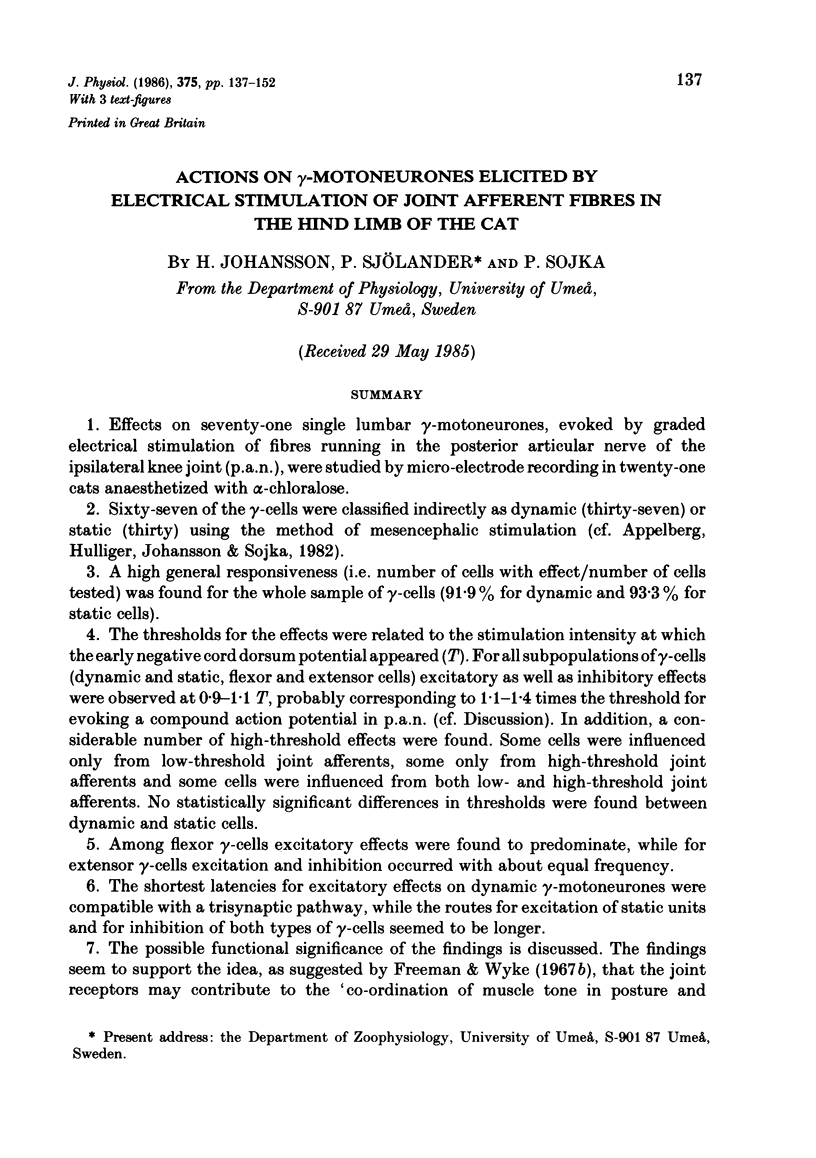
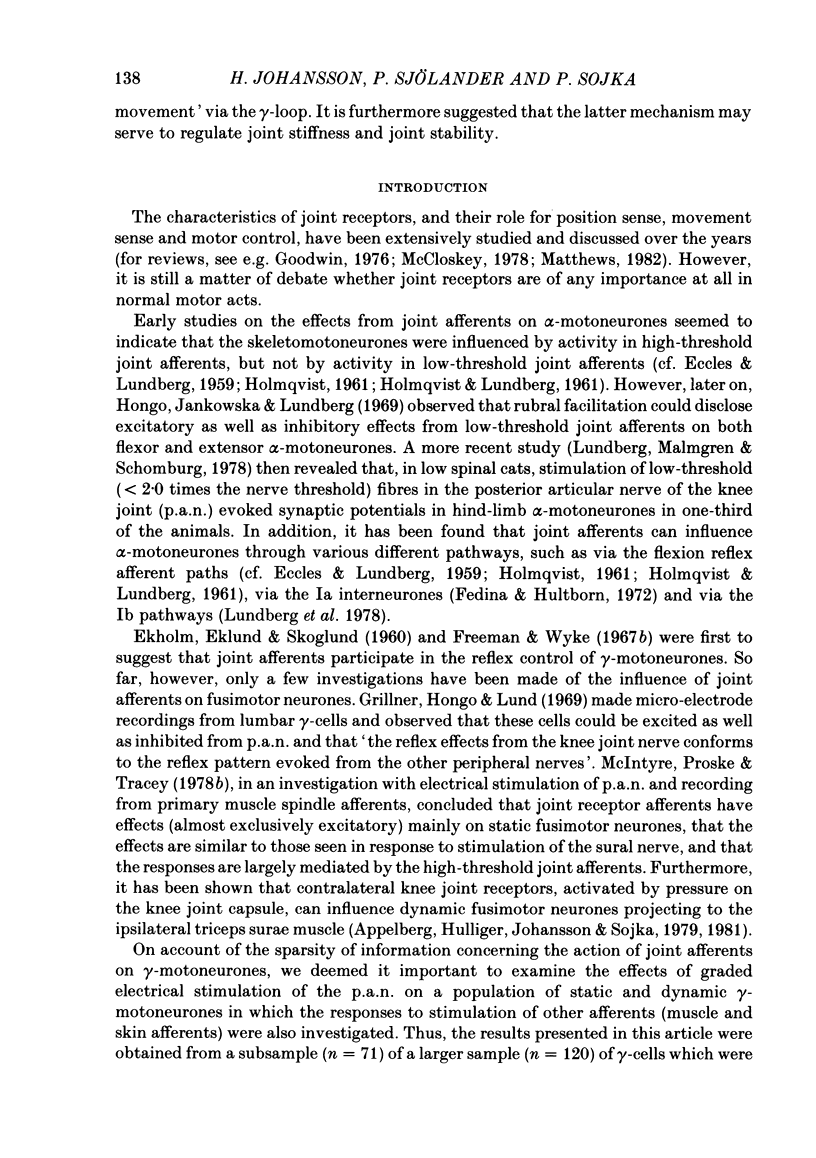
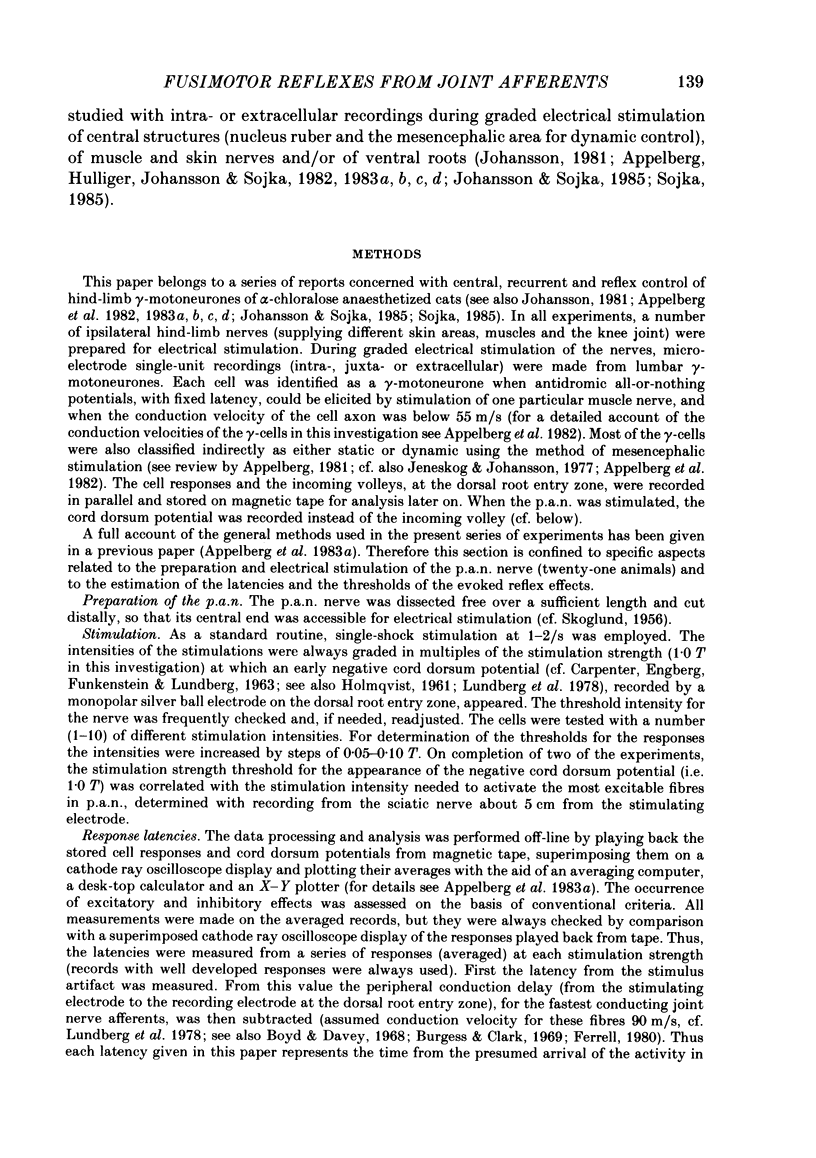

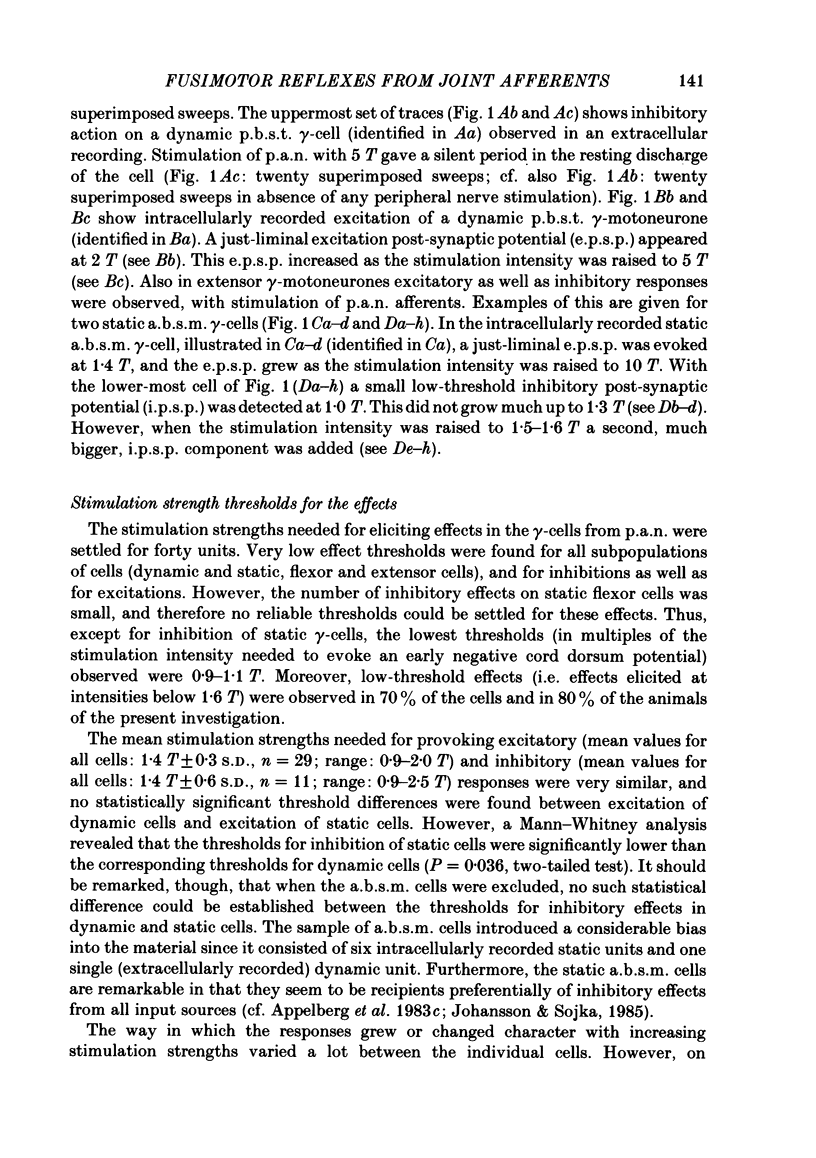
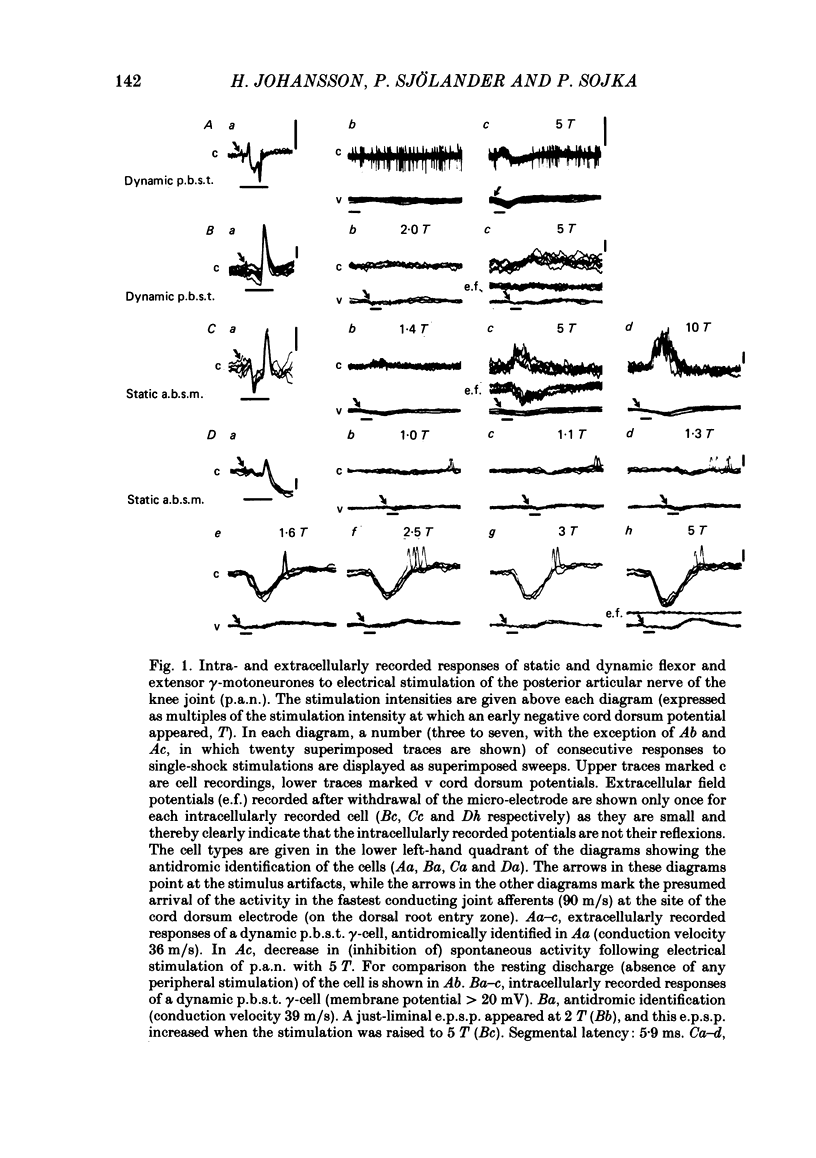
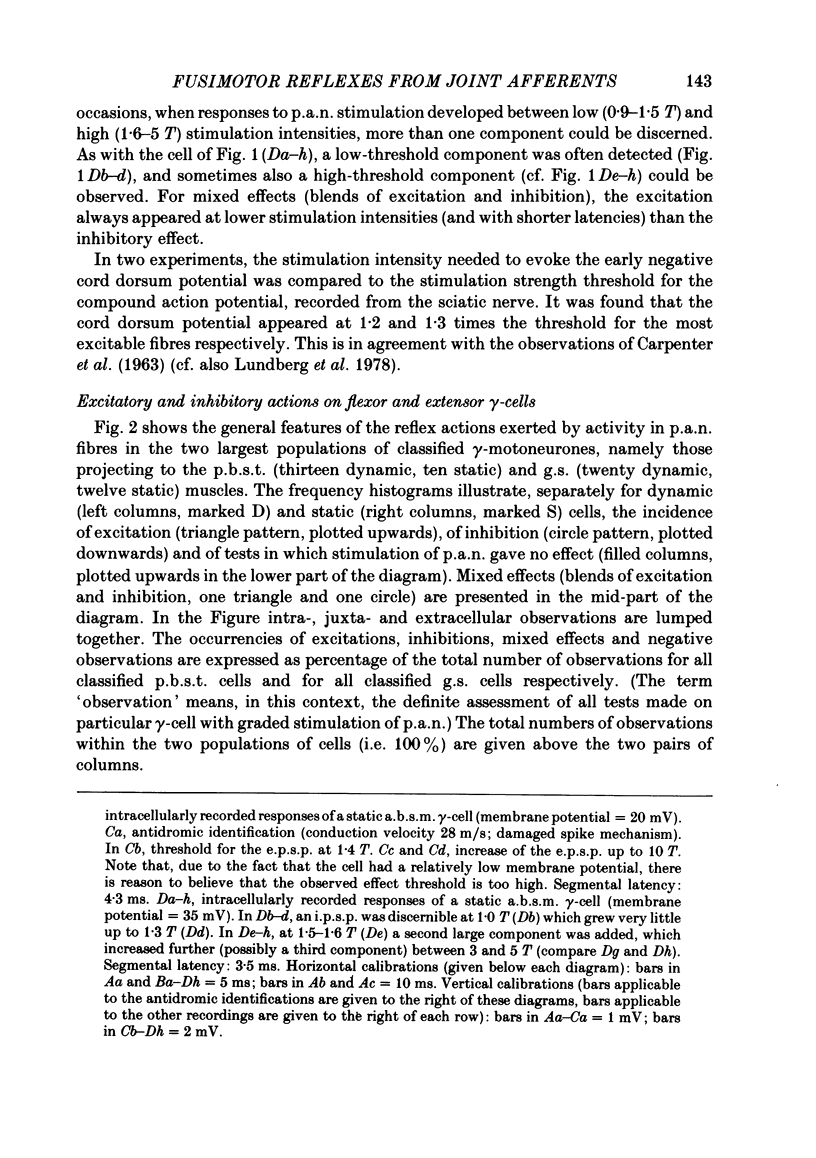
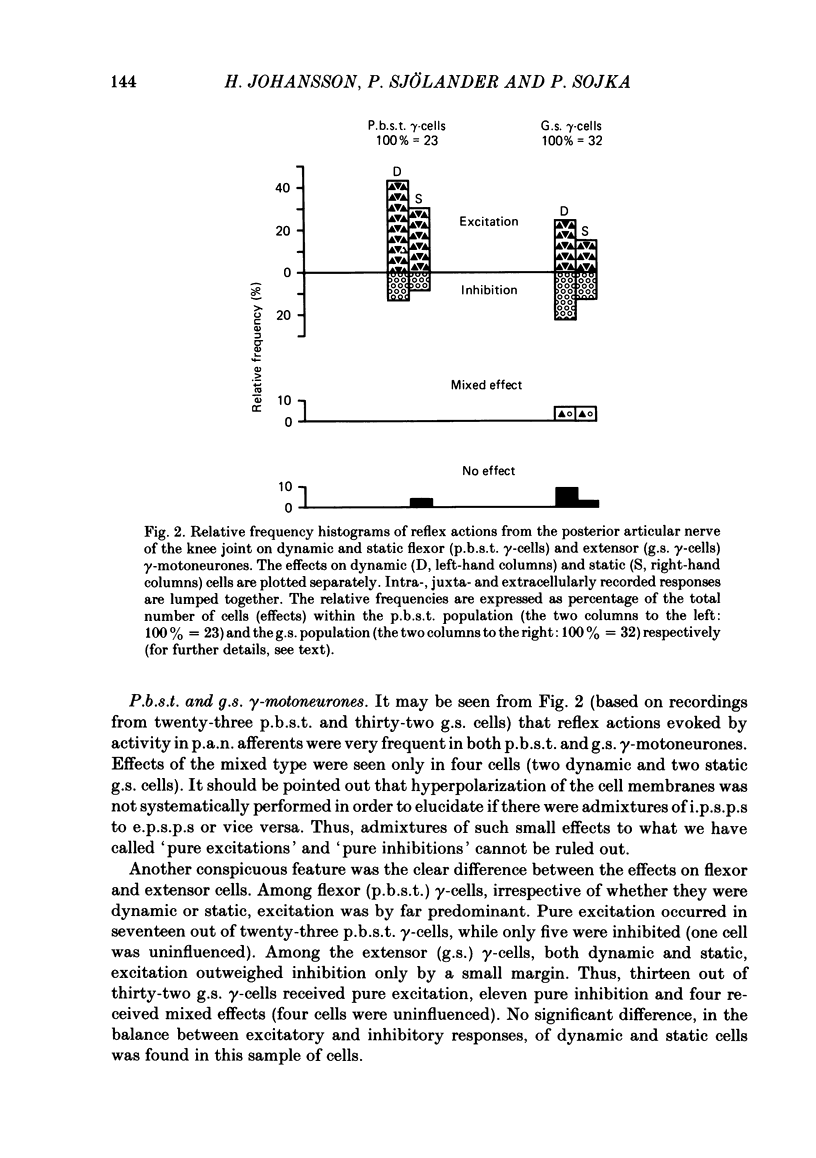
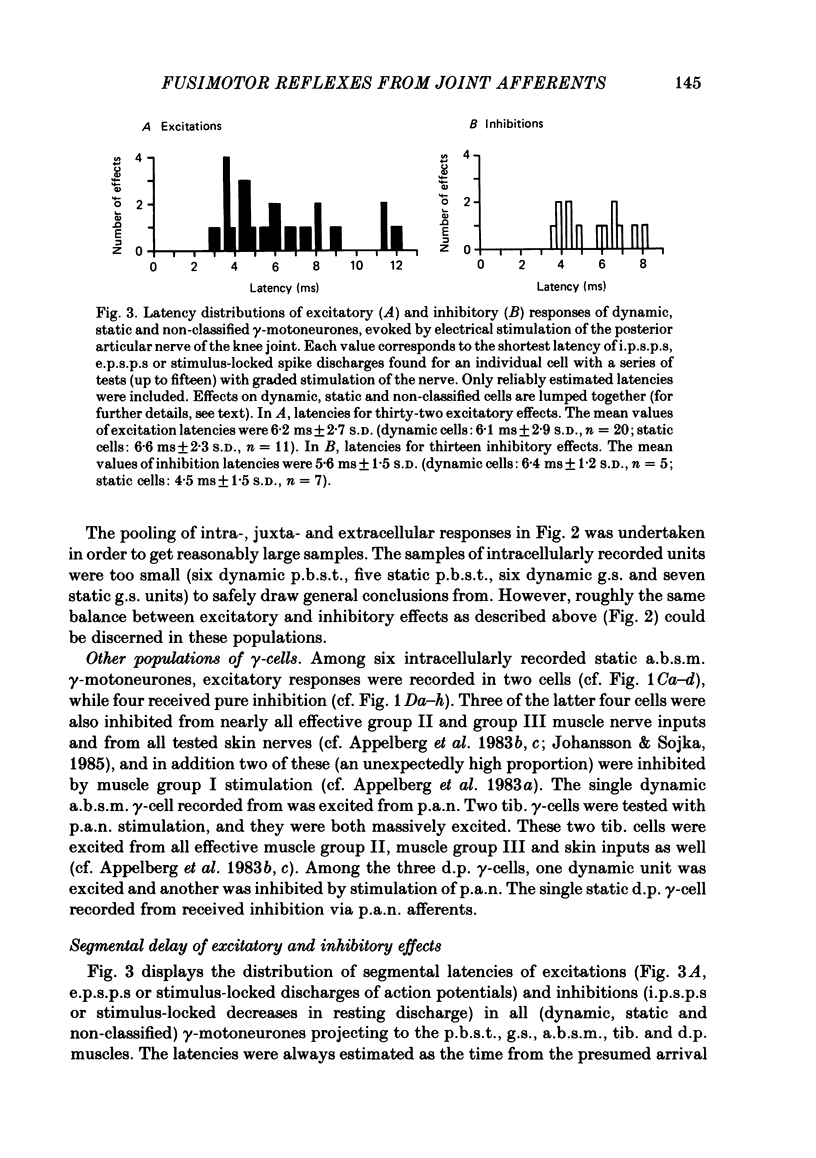
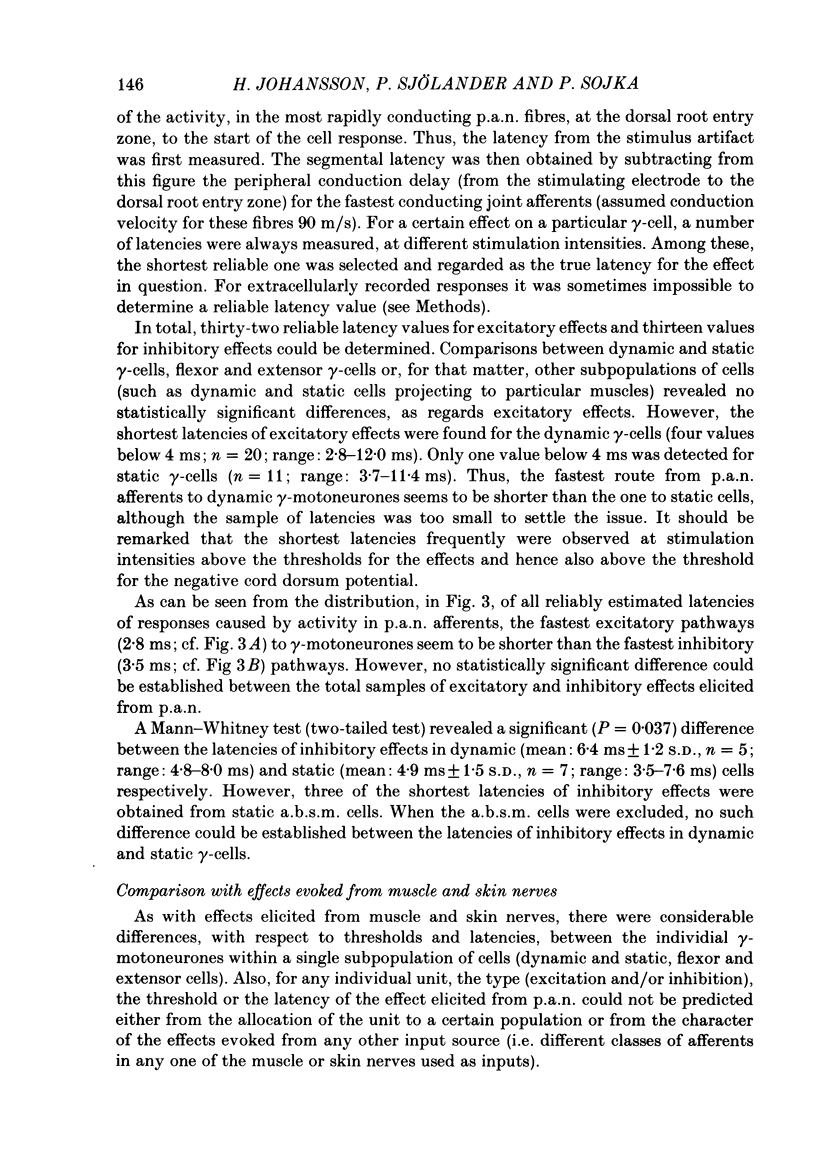
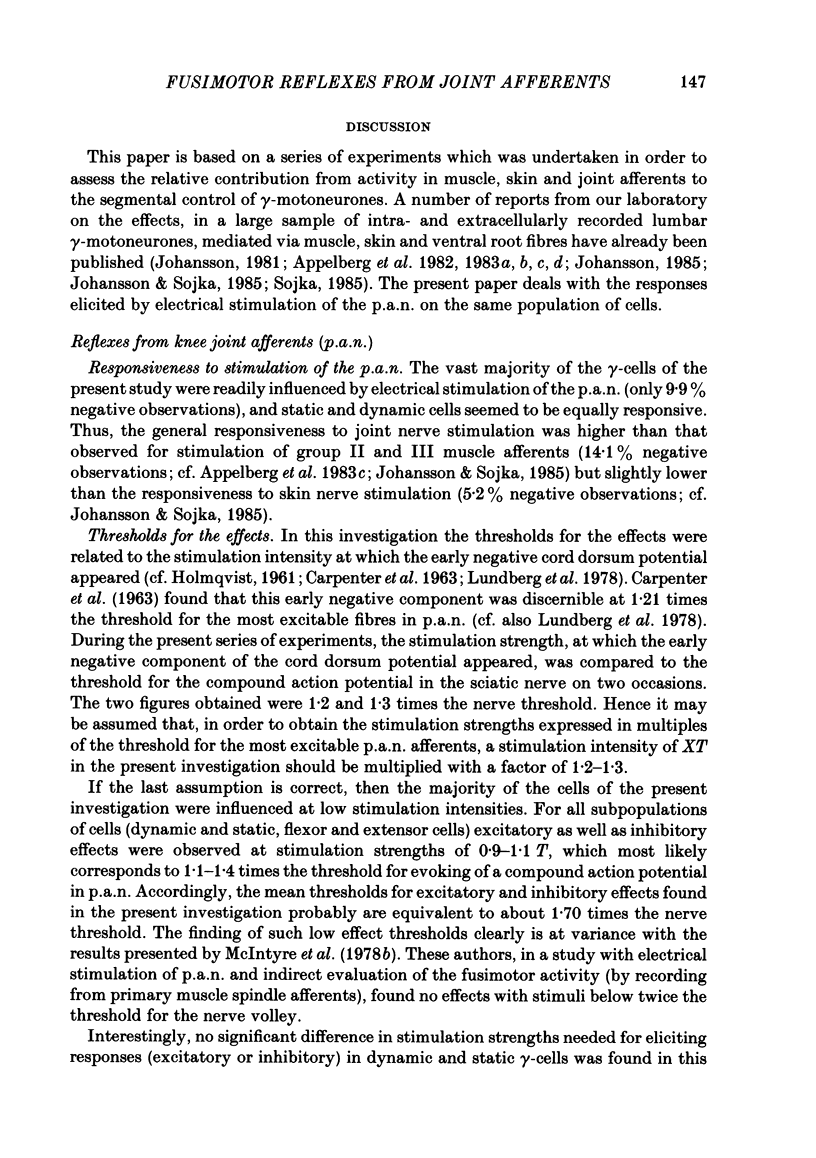
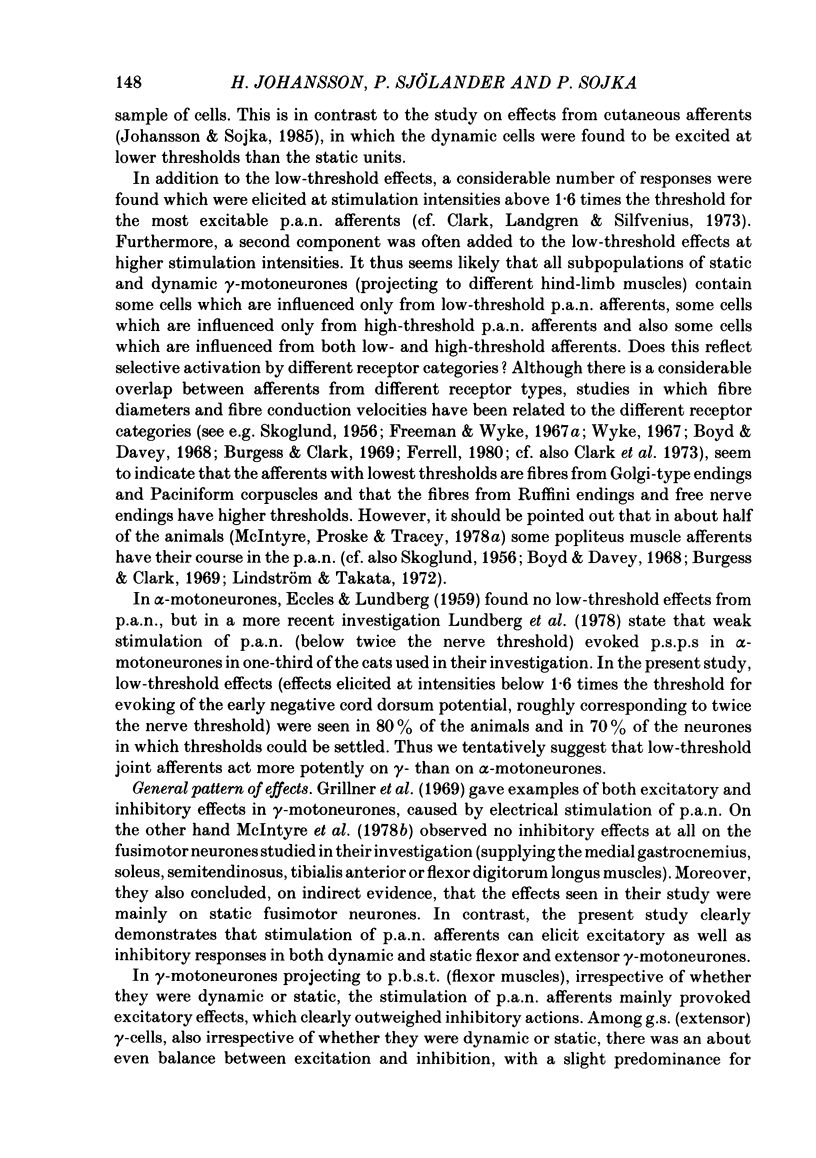
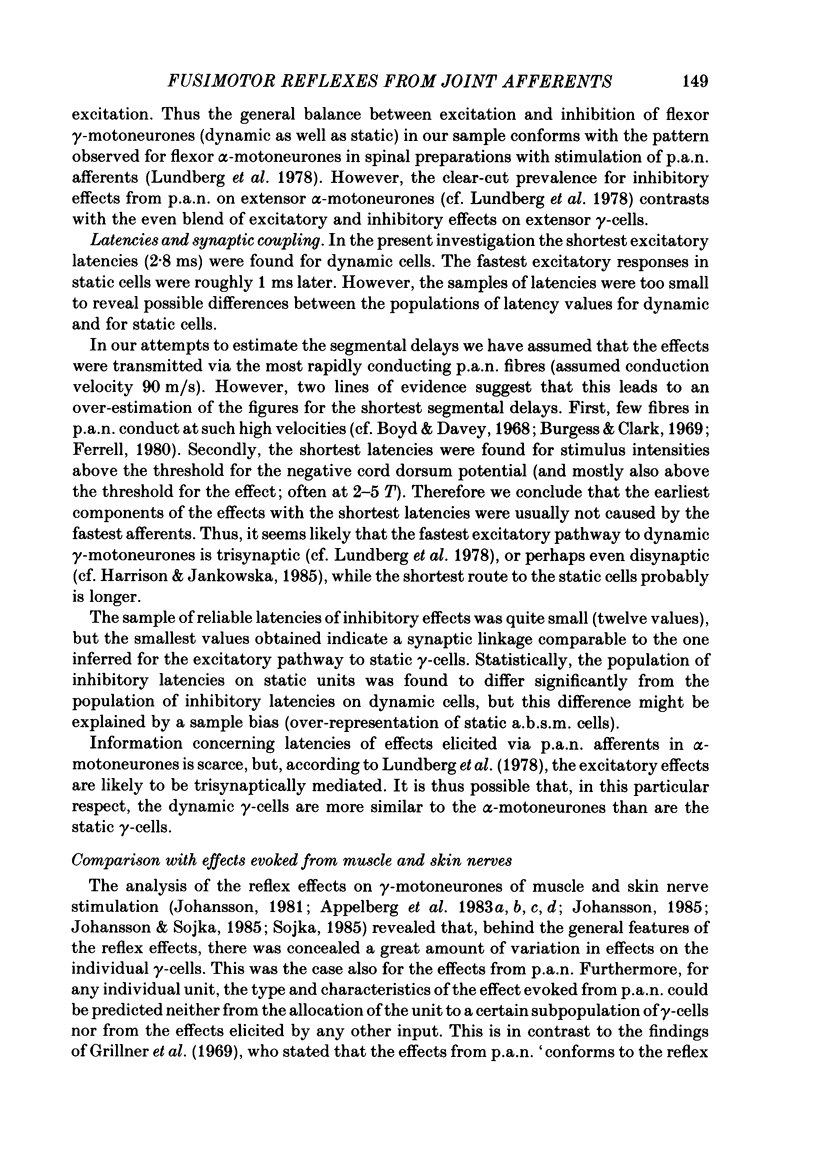
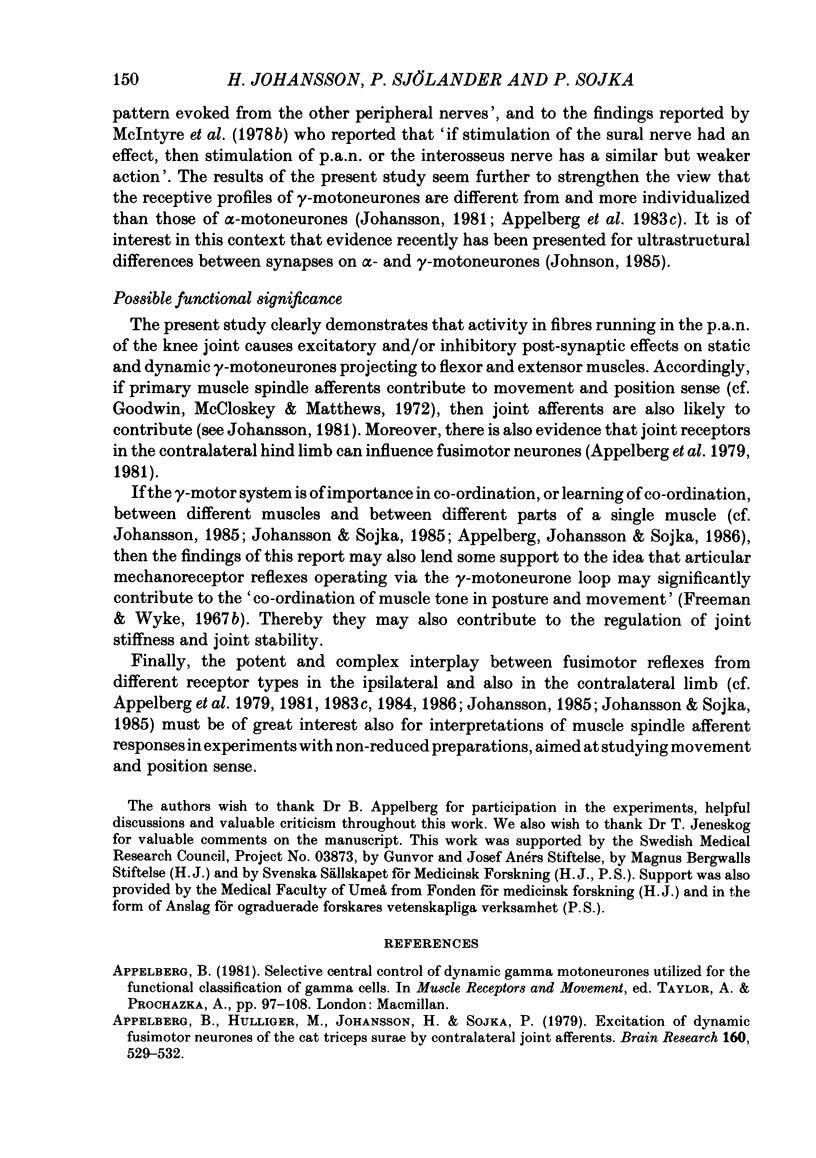
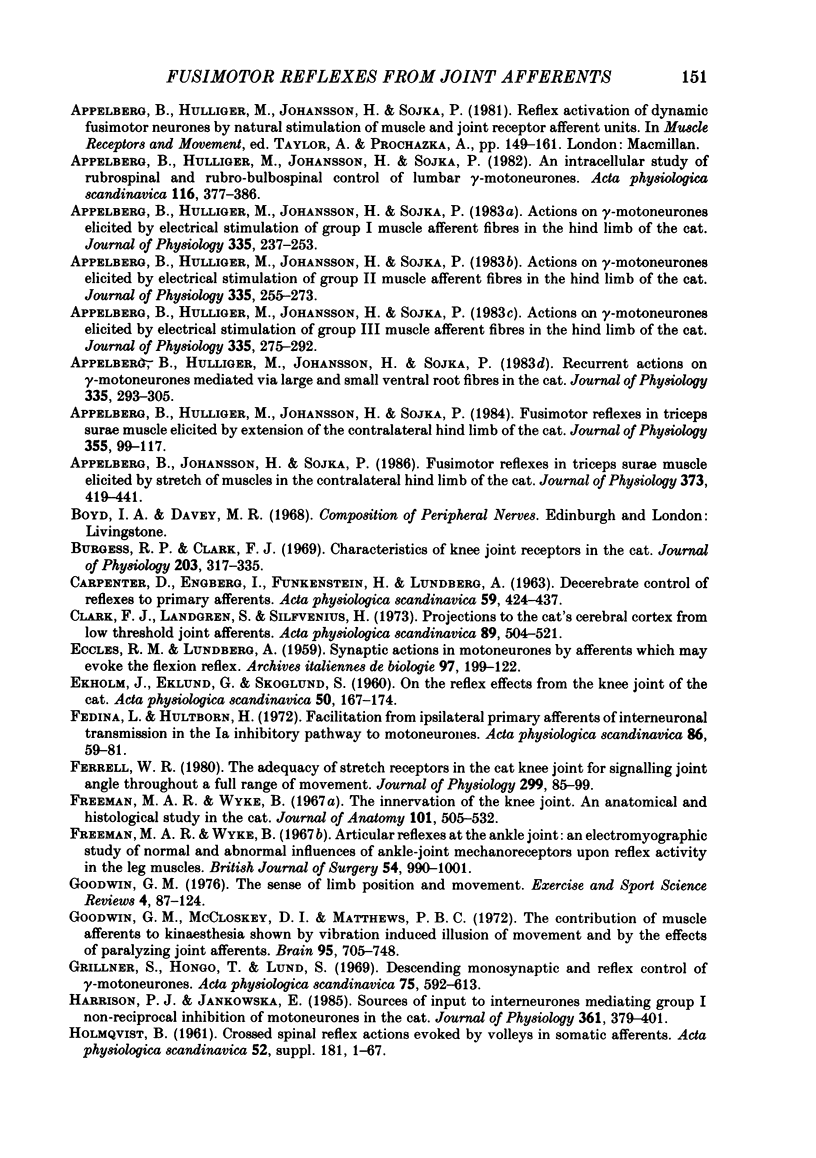
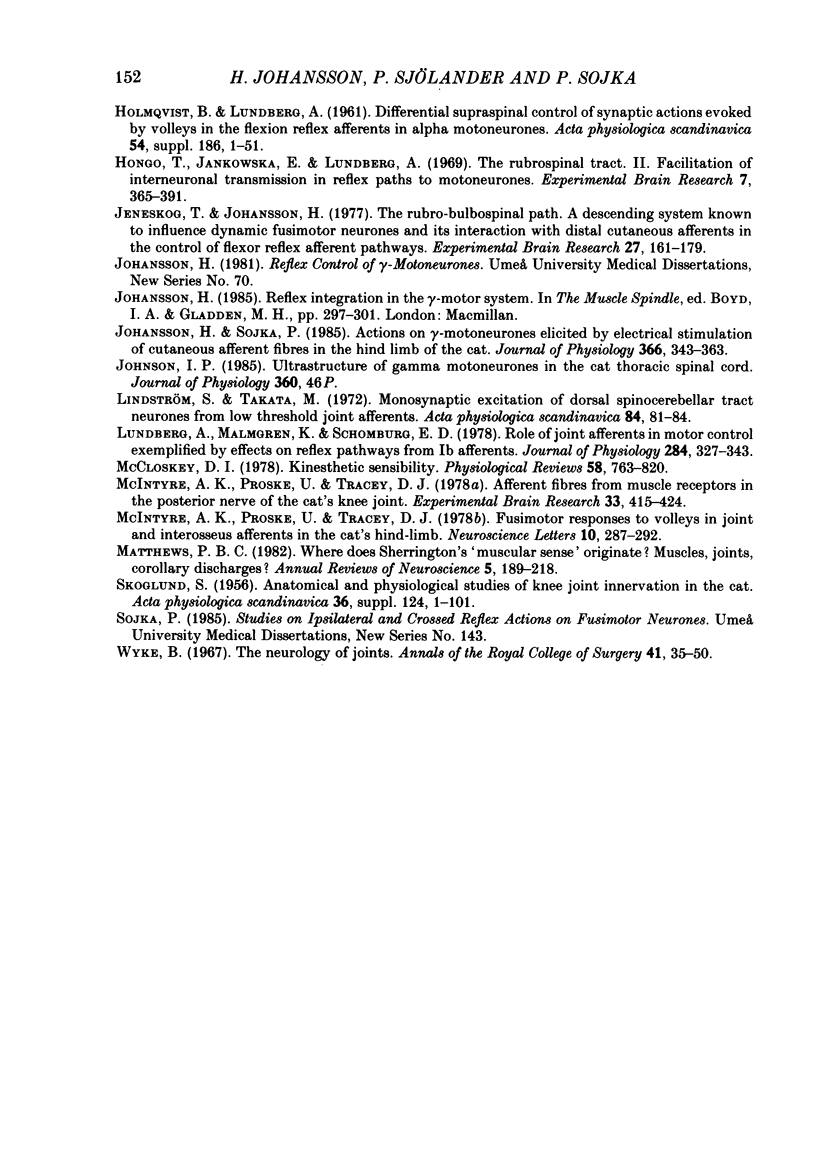
Selected References
These references are in PubMed. This may not be the complete list of references from this article.
- Appelberg B., Hulliger M., Johansson H., Sojka P. Actions on gamma-motoneurones elicited by electrical stimulation of group I muscle afferent fibres in the hind limb of the cat. J Physiol. 1983 Feb;335:237–253. doi: 10.1113/jphysiol.1983.sp014531. [DOI] [PMC free article] [PubMed] [Google Scholar]
- Appelberg B., Hulliger M., Johansson H., Sojka P. Actions on gamma-motoneurones elicited by electrical stimulation of group II muscle afferent fibres in the hind limb of the cat. J Physiol. 1983 Feb;335:255–273. doi: 10.1113/jphysiol.1983.sp014532. [DOI] [PMC free article] [PubMed] [Google Scholar]
- Appelberg B., Hulliger M., Johansson H., Sojka P. Actions on gamma-motoneurones elicited by electrical stimulation of group III muscle afferent fibres in the hind limb of the cat. J Physiol. 1983 Feb;335:275–292. doi: 10.1113/jphysiol.1983.sp014533. [DOI] [PMC free article] [PubMed] [Google Scholar]
- Appelberg B., Hulliger M., Johansson H., Sojka P. An intracellular study of rubrospinal and rubro-bulbospinal control of lumbar gamma-motoneurones. Acta Physiol Scand. 1982 Dec;116(4):377–386. doi: 10.1111/j.1748-1716.1982.tb07155.x. [DOI] [PubMed] [Google Scholar]
- Appelberg B., Hulliger M., Johansson H., Sojka P. Excitation of dynamic fusimotor neurones of the cat triceps surae by contralateral joint afferents. Brain Res. 1979 Jan 19;160(3):529–532. doi: 10.1016/0006-8993(79)91081-3. [DOI] [PubMed] [Google Scholar]
- Appelberg B., Hulliger M., Johansson H., Sojka P. Fusimotor reflexes in triceps surae muscle elicited by extension of the contralateral hind limb in the cat. J Physiol. 1984 Oct;355:99–117. doi: 10.1113/jphysiol.1984.sp015409. [DOI] [PMC free article] [PubMed] [Google Scholar]
- Appelberg B., Johansson H., Sojka P. Fusimotor reflexes in triceps surae muscle elicited by stretch of muscles in the contralateral hind limb of the cat. J Physiol. 1986 Apr;373:419–441. doi: 10.1113/jphysiol.1986.sp016056. [DOI] [PMC free article] [PubMed] [Google Scholar]
- Burgess P. R., Clark F. J. Characteristics of knee joint receptors in the cat. J Physiol. 1969 Aug;203(2):317–335. doi: 10.1113/jphysiol.1969.sp008866. [DOI] [PMC free article] [PubMed] [Google Scholar]
- CARPENTER D., ENGBERG I., FUNKENSTEIN H., LUNDBERG A. DECEREBRATE CONTROL OF REFLEXES TO PRIMARY AFFERENTS. Acta Physiol Scand. 1963 Dec;59:424–437. doi: 10.1111/j.1748-1716.1963.tb02758.x. [DOI] [PubMed] [Google Scholar]
- Clark F. J., Landgren S., Silfvenius H. Projections to the cat's cerebral cortex from low threshold joint afferents. Acta Physiol Scand. 1973 Dec;89(4):504–521. doi: 10.1111/j.1748-1716.1973.tb05544.x. [DOI] [PubMed] [Google Scholar]
- EKHOLM J., EKLUND G., SKOGLUND S. On the reflex effects from the knee joint of the cat. Acta Physiol Scand. 1960 Oct 31;50:167–174. doi: 10.1111/j.1748-1716.1960.tb02087.x. [DOI] [PubMed] [Google Scholar]
- Fedina L., Hultborn H. Facilitation from ipsilateral primary afferents of interneuronal transmission in the Ia inhibitory pathway to motoneurones. Acta Physiol Scand. 1972 Sep;86(1):59–81. doi: 10.1111/j.1748-1716.1972.tb00225.x. [DOI] [PubMed] [Google Scholar]
- Ferrell W. R. The adequacy of stretch receptors in the cat knee joint for signalling joint angle throughout a full range of movement. J Physiol. 1980 Feb;299:85–99. doi: 10.1113/jphysiol.1980.sp013112. [DOI] [PMC free article] [PubMed] [Google Scholar]
- Freeman M. A., Wyke B. Articular reflexes at the ankle joint: an electromyographic study of normal and abnormal influences of ankle-joint mechanoreceptors upon reflex activity in the leg muscles. Br J Surg. 1967 Dec;54(12):990–1001. doi: 10.1002/bjs.1800541204. [DOI] [PubMed] [Google Scholar]
- Freeman M. A., Wyke B. The innervation of the knee joint. An anatomical and histological study in the cat. J Anat. 1967 Jun;101(Pt 3):505–532. [PMC free article] [PubMed] [Google Scholar]
- Goodwin G. M., McCloskey D. I., Matthews P. B. The contribution of muscle afferents to kinaesthesia shown by vibration induced illusions of movement and by the effects of paralysing joint afferents. Brain. 1972;95(4):705–748. doi: 10.1093/brain/95.4.705. [DOI] [PubMed] [Google Scholar]
- Goodwin G. M. The sense of limb position and movement. Exerc Sport Sci Rev. 1976;4:87–124. [PubMed] [Google Scholar]
- Grillner S., Hongo T., Lund S. Descending monosynaptic and reflex control of gamma-motoneurones. Acta Physiol Scand. 1969 Apr;75(4):592–613. doi: 10.1111/j.1748-1716.1969.tb04414.x. [DOI] [PubMed] [Google Scholar]
- Harrison P. J., Jankowska E. Sources of input to interneurones mediating group I non-reciprocal inhibition of motoneurones in the cat. J Physiol. 1985 Apr;361:379–401. doi: 10.1113/jphysiol.1985.sp015651. [DOI] [PMC free article] [PubMed] [Google Scholar]
- Hongo T., Jankowska E., Lundberg A. The rubrospinal tract. II. Facilitation of interneuronal transmission in reflex paths to motoneurones. Exp Brain Res. 1969;7(4):365–391. doi: 10.1007/BF00237321. [DOI] [PubMed] [Google Scholar]
- Jeneskog T., Johansson H. The rubro-bulbospinal path. A descending system known to influence dynamic fusimotor neurones and its interaction with distal cutaneous afferents in the control of flexor reflex afferent pathways. Exp Brain Res. 1977 Feb 16;27(2):161–179. doi: 10.1007/BF00237696. [DOI] [PubMed] [Google Scholar]
- Johansson H., Sojka P. Actions on gamma-motoneurones elicited by electrical stimulation of cutaneous afferent fibres in the hind limb of the cat. J Physiol. 1985 Sep;366:343–363. doi: 10.1113/jphysiol.1985.sp015802. [DOI] [PMC free article] [PubMed] [Google Scholar]
- Lundberg A., Malmgren K., Schomburg E. D. Role of joint afferents in motor control exemplified by effects on reflex pathways from Ib afferents. J Physiol. 1978 Nov;284:327–343. doi: 10.1113/jphysiol.1978.sp012543. [DOI] [PMC free article] [PubMed] [Google Scholar]
- Matthews P. B. Where does Sherrington's "muscular sense" originate? Muscles, joints, corollary discharges? Annu Rev Neurosci. 1982;5:189–218. doi: 10.1146/annurev.ne.05.030182.001201. [DOI] [PubMed] [Google Scholar]
- McCloskey D. I. Kinesthetic sensibility. Physiol Rev. 1978 Oct;58(4):763–820. doi: 10.1152/physrev.1978.58.4.763. [DOI] [PubMed] [Google Scholar]
- McIntyre A. K., Proske U., Tracey D. J. Afferent fibres from muscle receptors in the posterior nerve of the cat's knee joint. Exp Brain Res. 1978 Nov 15;33(3-4):415–424. doi: 10.1007/BF00235563. [DOI] [PubMed] [Google Scholar]
- SKOGLUND S. Anatomical and physiological studies of knee joint innervation in the cat. Acta Physiol Scand Suppl. 1956;36(124):1–101. [PubMed] [Google Scholar]


